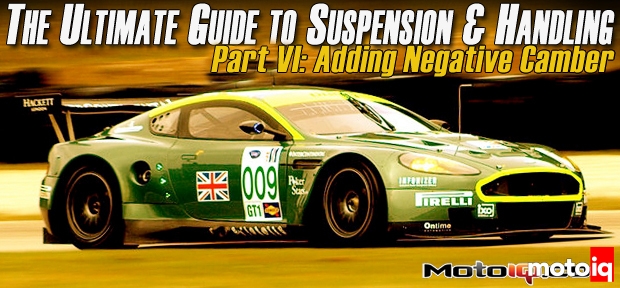,
 |
| This picture illustrates what happens to a tire and suspension under roll and heavy cornering load. As the car rolls, the bushings can deflect and the amount of negative camber gain in the suspension’s geometry cannot keep up with the loss of camber under roll. The tire ends up tilting toward positive camber. In addition the tread lifts and distorts under roll, loading the outside and lifting the inside. You can see how adding a few degrees of static negative camber is going to really help a lot here. You might wonder why the engineers of the suspension system didn’t design the suspension geometry to gain more negative camber under roll. The answer is that a high degree of negative camber gain gain will cause the car to feel unstable and hunt, especially over bumps when the car is going straight. The solution is to increase roll stiffness to limit roll, run harder bushings and increase negative camber. |
As a car rolls in a corner, the chassis roll tilts the tire onto its outside edge making the problem worse. Keeping the tires flat on the road is the primary reason to reduce roll. In Part One we listed several ways to do this, the easiest ways are to increase spring rate or use larger anti-roll bars. However, the primary tool used for combating tread lift is to run more negative camber. Camber is the inward or outward tilt of the tires when looking at them from the front. Positive camber is when the top of the tire tips outward while negative camber is when the top of the tire tilts inward.
 |
| High performance radial tires typicaly generate more camber thrust than this but the curve rolls off faster as the camber gets past 5 or more degrees. Camber thrust helps mechanical grip. |
Another often overlooked positive factor regarding adding negative camber is camber thrust. Tires, when tilted towards negative camber, particularly radial tires, generate an inward facing force. This force is generated by the tire wanting to return to its normal undistorted condition. It is both an elastic and a pneumatic force. In a corner, the heavily loaded outside tires when run with a lot of negative camber can provide an inward force vector of up to several hundred pounds. This helps generate more mechanical grip. Typically a modern radial competition tire generates peak camber thrust at around 4 degrees negative camber. Unfortunately most tire companies will not release this data so it must be estimated through tuning and trial and error.
 |
| This illustration shows the tire profile distortion typical of what happens under side load. This is not exaggerated. On the track it can be much worse to where the tire actually runs up on the sidewall and half the inside tread lifts off the ground. Negative camber counteracts this. |
Dialing in negative camber helps combat tread lift and roll related wheel tilt. Camber thrust is also generated. The trick is to add just enough negative camber so the tread stays flat and 100 percent engaged with the ground under side load and roll while maximizing the camber thrust effect. Adding too much negative camber will hurt more than it helps. Too much negative camber will:
• Reduce braking traction.
• Reduce acceleration traction if it’s applied on the drive wheels.
• Increase the tendency to tramline (following cracks and grooves in the pavement)
• Increase crown sensitivity (wandering caused by road contour).
• Affect tire wear; the insides of the tire tread will wear faster with more negative camber if you don’t corner hard. Conversely, if you constantly corner hard, your tires will wear more evenly and last longer



